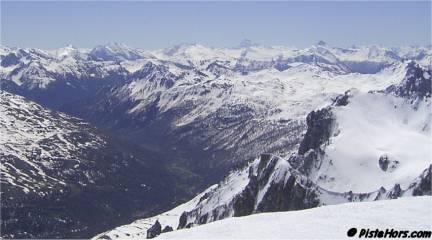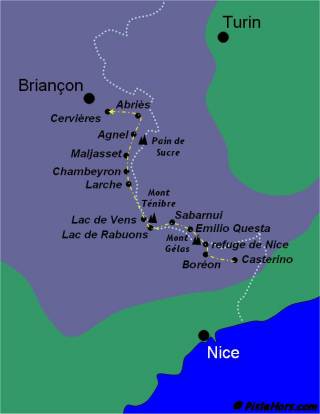A landslide at the weekend has blocked the road to Castérino. Holiday makers and a dozen residents have been evacuated by helicopter but work to reestablish access to this tiny village is expected to take 2 to 3 months.

Even in the deep mid-winter, when Chamonix is blanketed in snow and Grenoble is dull-grey under a stormy mantle of cloud, days can be pleasant strolling along the Promenade des Anglais at Nice. The azure blue of the Mediterranean Sea lapping on the pebbled shoreline. What better place to start an adventure into the mountains of the Maritime Alps and beyond?

There is something romantic about a long tour on skis. A “raid” as the French call it. The route from Nice inland is not often travelled but it has a rich history. On the 1st of February 1933 Leon Zwingelstein set out from la Grave on skis for Nice under brilliant sunshine. He wanted to acclimatise himself for a trip covering the entire Alpine arc. Nice to the Tyrol. Starting on the 7th of February he climbed 60,000 meters over 2000 km finishing on the 1st of May. Alone, carrying a tent, supplies and with 2 meter heavy Hickory “telemark” skis, taking in fifty mountain passes and glaciers on the way. On the 7th of June he passed back through Chamonix and finished his season with Mont-Blanc. Eight hours to the Grand-Mulets, six hours to the summit and just over four to ski back to Cham. Figures that modern day skiers would be more than happy with. Zwing’s feat was repeated by Patrick and Marie-Jo Vallençant in the spring of 1972 and every year one or two teams repeat the journey.
With the spring touring season underway we wanted to find out what the logistics are for a long tour on skis. Grenoble based ski mountaineer Cecile Gondrand caught the bug last year crossing Corsica by the Alta Strada. A wild and potentially dangerous trek. Ten days with friends far from civilization, snow, sea, skis, endless vistas where normal life is left far behind and the preoccupations are the snow conditions, heavy rucksacks, the ever variable weather, finding refuge, drinking and eating enough for the following day’s effort.
This year her group had ideas beyond the borders of France but realized that the logistics of organizing such a tour, without a guide, were perhaps too much. Instead they settled on the historic high route from Nice to Briançon. Mountains left relatively untouched by the ski industry found to the north. The voyage would offer the elements they craved. Solitude and self-reliance.
Next step was organizing a trip over twelve days in mid-March. Maps had to be studied. Guidebooks and friends interrogated for precious items of information. The route would cover the mountains from Casterino to Cervières stopping at the refuges: Nice, Questa Emilio, Sabarnui, Lac de Rabuons, Lac de Vens, Chambeyron, Maljasset, Agnel and slightly more luxurious gîtes at Boréon, Larche and les Abriès. The route would offer the chance, weather permitting, to bag a few well known summits such as le Gelas and le Ténibre. 16,000 meters of climbing and eight well motivated skiers none of whom had ever covered twelve long and hard days of skiing.

The team sent four food parcels ahead. A small luxury to avoid carrying ten kilograms of food each. They still had to carry stoves and gas. Not every refuge was equipped for cooking or had wood to dry wet climbing skins and clothes for the next leg. Others were more luxurious such as the refuge Sabarnui with running water and loos or the refuge de Chambeyron heated by a cozy coal fired stove.
The view leaving Casterino, reached by taxi from Nice, is an amazing set of contrasts, blue sky, brilliant white snow, towering peaks and the glistening sea as a backdrop. The mountains of Argentera and Viso loom in the distance. There is the strange feeling of being surrounded by unfamiliar landscapes. The heavy load of full rucksacks. Discussions about route choices, whether it is better to descend or try to traverse keeping climbing skins on skis. The pressures of keeping to schedules to avoid dangerous slopes during the heat of the day or to arrive at the next refuge before nightfall. The work of finding and cutting wood for heating and melting snow while the lights of civilization glitter far below in the cold mountain air.
Route finding is always a problem and traverses are always more complicated as you do not know what conditions you might encounter. Crampons and an ice axe are essential items as are maps, compass and an altimeter. A GPS can be useful for navigating up long featureless valleys in low cloud.
Giving that 2006 was one of the deadliest winters on record for avalanches in France the group only had one moment of doubt about the snow pack, on the eighth day climbing to the Cime de l’Enchastraye. Cecile comments that “it is a fairly steep slope and given the hour it was getting pretty warm. We found a more shaded part of the slope to climb and got a move on but it is not easy to reach agreement with a group of eight”. The next day they had three passes to climb, all with steep slopes on the north sides. A big unknown especially as the weather had worsened. The alternative was a long walk on a tarmac road. In the end they set out for the cols with the option of doing a U-turn at the first. En-route they met a Swiss group who were heading for their homeland over 1 week. 3000 meters of climbing a day on average but equipped with small 25 liter day sacks. The poor weather meant that ideas of skiing on the slopes of the Pic d’Asti or Pain de Sucre had to be abandoned. The essential was to arrive at the end of the leg. At the refuge d’Agnel they descended too far in the dense clouds, found their route blocked by cliffs and had to climb back up. Not the most pleasant end to the day.
The final day was perfect, or nearly. An alpine start at 3h30 meant that the first pitch was in the dark. Difficult to follow the zig-zagging trail and the group got lost in the brushwood. After that the snow was perfect and the weather superb. 1800 meters to the summit of Grand Glaiza (3293 meters) the high point of the whole voyage. The final eleven kilometers on the cross country skiing trails to Cervières were physical. Then Briançon and the bus home to Grenoble.
Cécile concludes that “it is a super trip, we hardly saw a soul. The first legs to the Larch are the most remote and wild but without the luxury of guarded refuges and with a number of airy passages under the warm Mediterranean sun. It is not easy to do 1500 meters every day with heavy sixty five liter rucksacks weighing around fifteen kilograms. Especially when you don’t always sleep or eat well. Still we did it under our own steam, apart from a few beers bought in guarded refuge. Managing a group of eight, when everyone is tired, was instructive. It is a trip I wholeheartedly recommend, twelve days far from the madding crowds just the pleasure to be in the mountains”
Further Information:
Nice - Briançon link in French with photos.
A landslide at the weekend has blocked the road to Castérino. Holiday makers and a dozen residents have been evacuated by helicopter but work to reestablish access to this tiny village is expected to take 2 to 3 months.